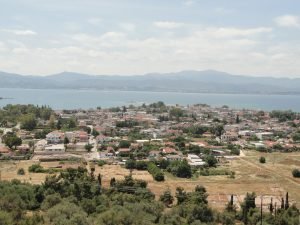 Eretria (not to be confused, of course, with the African nation of Eritrea) is a town located on the southern coast of the Greek island of Euboea (Evia) 18 km southeast of the island’s main town of Chalkida (Chalcis).
Eretria (not to be confused, of course, with the African nation of Eritrea) is a town located on the southern coast of the Greek island of Euboea (Evia) 18 km southeast of the island’s main town of Chalkida (Chalcis).
The area around where the modern city stands today has been inhabited since the Neolithic period, and evidence of human settlement in Eretria itself dates back to the 3rd millennium BCE. This was the Early Helladic period, which was the beginning of the Bronze Age in mainland Greece. There are also remains from the later periods of the Bronze Age, but nothing significant from the years immediately following the widespread societal collapses that accompanied the end of the Bronze Age.
 However, the city seems to have been quickly resettled. Indeed, one of the most crucial periods of Eretria’s history was during the early Iron Age in the first few centuries of the first millennium BCE. This time is also known as the Protogeometric and Geometric periods, and it was during this time that Greek culture emerged in its newer form in the wake of the collapses at the end of the Bronze Age. This newer form included a new alphabet, which was based on the Phoenician alphabet. The earliest version of the Greek alphabet is the Evian alphabet, and so archaeologists say that Eretria and other sites in Evia (such as Lefkandi, which is just 10 km to the west) which were important towns during this period must have been at the forefront of the development and diffusion of the new Greek culture which was emerging. After all, cultural elements like the new alphabet did not develop in Evia by accident. It was Evia’s role as a trade and communications conduit between mainland Greece and the older civilizations to the east which saw the new Greek culture emerge there first.
However, the city seems to have been quickly resettled. Indeed, one of the most crucial periods of Eretria’s history was during the early Iron Age in the first few centuries of the first millennium BCE. This time is also known as the Protogeometric and Geometric periods, and it was during this time that Greek culture emerged in its newer form in the wake of the collapses at the end of the Bronze Age. This newer form included a new alphabet, which was based on the Phoenician alphabet. The earliest version of the Greek alphabet is the Evian alphabet, and so archaeologists say that Eretria and other sites in Evia (such as Lefkandi, which is just 10 km to the west) which were important towns during this period must have been at the forefront of the development and diffusion of the new Greek culture which was emerging. After all, cultural elements like the new alphabet did not develop in Evia by accident. It was Evia’s role as a trade and communications conduit between mainland Greece and the older civilizations to the east which saw the new Greek culture emerge there first.
Eretria’s history continued throughout the rest of antiquity, during which time it had close ties with Athens, including Athenian domination during some periods. In 490 BCE, the city was destroyed by the Persians because of its support for the revolting Greek colonies in Asia Minor. (The Persians tried to punish Athens the same way that same year but were stopped at the Battle of Marathon.) The city recovered, and thus it survived into the Classical, Hellenistic, and Roman periods. However, in 86 BCE the city was once again destroyed as punishment for siding with a rebellion, this time by the Romans for its support of the revolt of Mithridates VI the previous year. On this occasion, however, the city seems not to have recovered afterwards.
As most visits to the archaeological remains of Eretria start at the museum, it makes sense to begin exploring the site at the cluster of structures just north of the museum. This was the neighborhood around the western gate of the city, where there were large mansions, smaller houses, a heroon, and of course the West Gate itself.

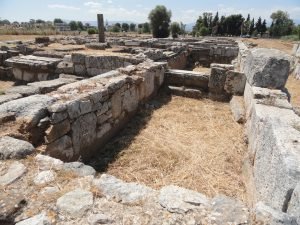

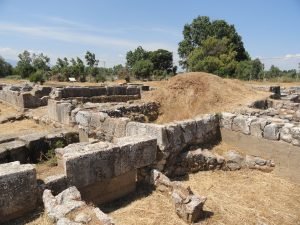
Just to the northwest of the West Gate is where the 5th-century-BCE theater stood, built against an artificial mound. In front of the theater are the foundations of a 4th-century-BCE temple dedicated to Dionysus.
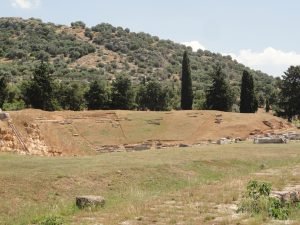

Just east of the temple was a gymnasium from the late Classical period.
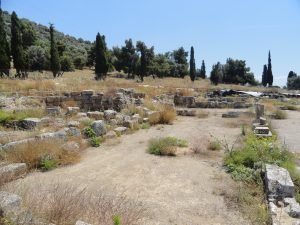
The trail that leads north from the gymnasium goes up the hill to the acropolis. There are remnants of fortification walls as well as ruins of a sanctuary of Artemis where activities related to the Thesmophoria festival took place.

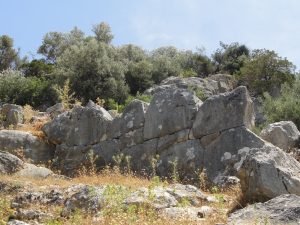
Southeast of the gymnasium, right at the northern edge of the modern town, is a cluster of ancient structures. One plot of land here has been called the Panathenaic Amphorae Quarter.


The highlight in this part of the site is the so-called “House of the Mosaics,” which was in use from around 370 until its destruction by fire in 270 BCE. The house featured several mosaics as well as tombs.
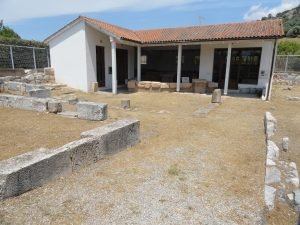



A few blocks south of the House of the Mosaics are the sandstone foundations of what must have been the grandest building in ancient Eretria, the Temple of Apollo Daphnephoros. Although there was an earlier incarnation of the temple built in the early Iron Age, the topmost layer of the foundations contain the remains of the last version of the temple, which dates to the Archaic period (just before the Classical period), and in fact it might not have been finished at the time of its destruction by the Persians in 490 BCE. Some of the statuary which was used in the pediments of the temple is on display at the museum.

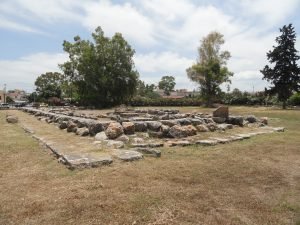
A couple of blocks further south is the center of the modern town, as well as where the Roman baths and the agora once stood. The remains of the foundations of the baths as well as what is left of a tholos that was part of the agora can be viewed there.


At the eastern edge of the modern town are two more structures of the ancient city: a 4th-century-BCE temple dedicated to the Egyptian goddess Isis and another gymnasium, which like its counterpart in the north of town also dates to the Classical period.


At the small but splendid archaeological museum, visitors can admire many interesting finds from Eretria (as well as from other nearby sites, including Lefkandi).


Also on display inside the museum are impressive models of the House of the Mosaics and the Temple of Apollo Daphnephoros. Note that the latter is shown in the model to be still under construction, which is appropriate as it is unknown whether the temple was completed before it was destroyed.

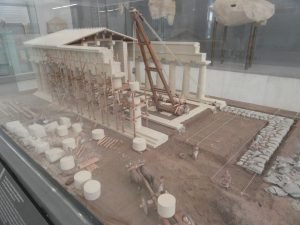
There are also some exhibits in the courtyard and under some sheltered patios along the edge of the building. Most of the objects on display there are statues and grave markers, but also significant is the pottery kiln, which is believed to have been in use in the Middle Helladic period (early 2nd millennium BCE).
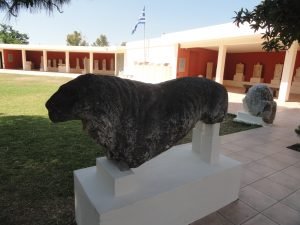

Tips for the Visitor
The quickest way to get to Eretria from Athens by public transportation is to first take a bus from Mavromateon Street just a couple of blocks east of Victoria metro station to Skala Oropou, a town on the northern coast of Attica. The journey takes a little over an hour and costs 5.20 euro. You can get off the bus at the ferry terminal in Skala Oropou and catch the next ferry, which will take you on a 20-minute journey across the gulf that separates Attica and Evia directly to Eretria. The ferries usually run every half hour and cost 2 euro per person. They also take cars and motorbikes if you have one.
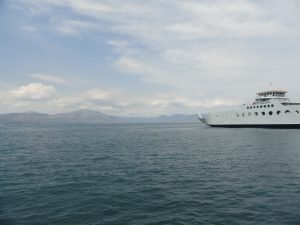 From the ferry terminal in Eretria, the archaeological museum is less than a kilometer to the northwest. Entry costs 2 euro, and it is closed on Tuesdays. The museum will give you a photocopied map showing you where the ruins are to be found around town, so you can easily set yourself off to explore after your visit. Note that the information placards in the museum are written only in Greek and French.
From the ferry terminal in Eretria, the archaeological museum is less than a kilometer to the northwest. Entry costs 2 euro, and it is closed on Tuesdays. The museum will give you a photocopied map showing you where the ruins are to be found around town, so you can easily set yourself off to explore after your visit. Note that the information placards in the museum are written only in Greek and French.
The majority of the archaeological ruins are fenced off. Most of the fenced-off areas are accessible through an open gate–at least during daylight hours–but some places such as the theater, both gymnasia, the Temple of Dionysus, the Temple of Isis, and the tholos are always off-limits. However, they can easily be viewed from beyond the fencing. The ruins on the acropolis (including the Thesmophorion) are not fenced off and can be visited anytime.
Location Map
